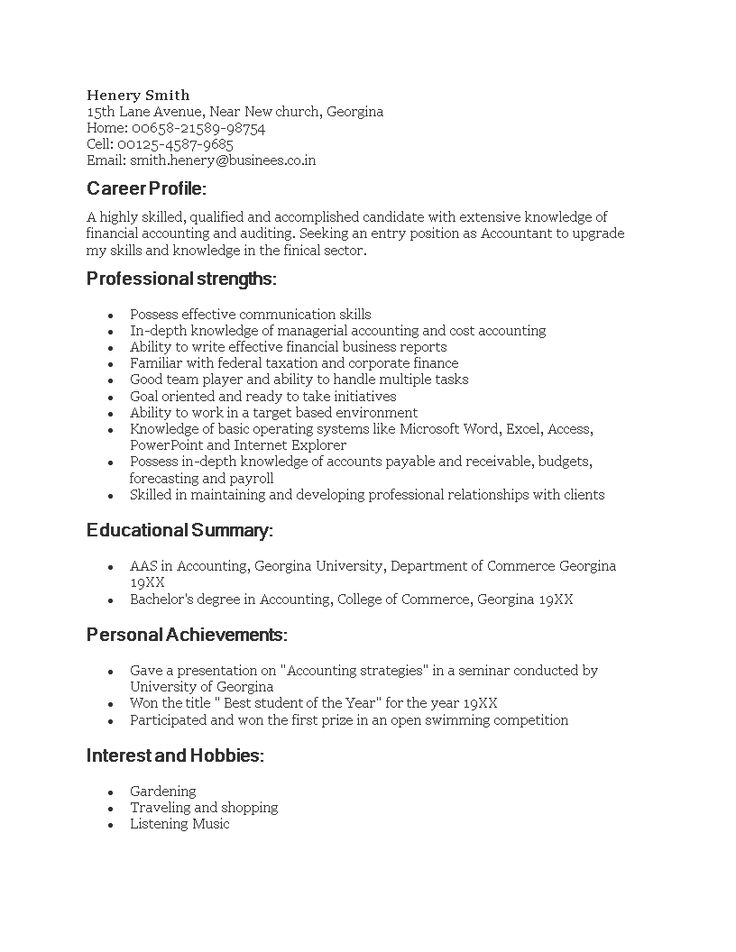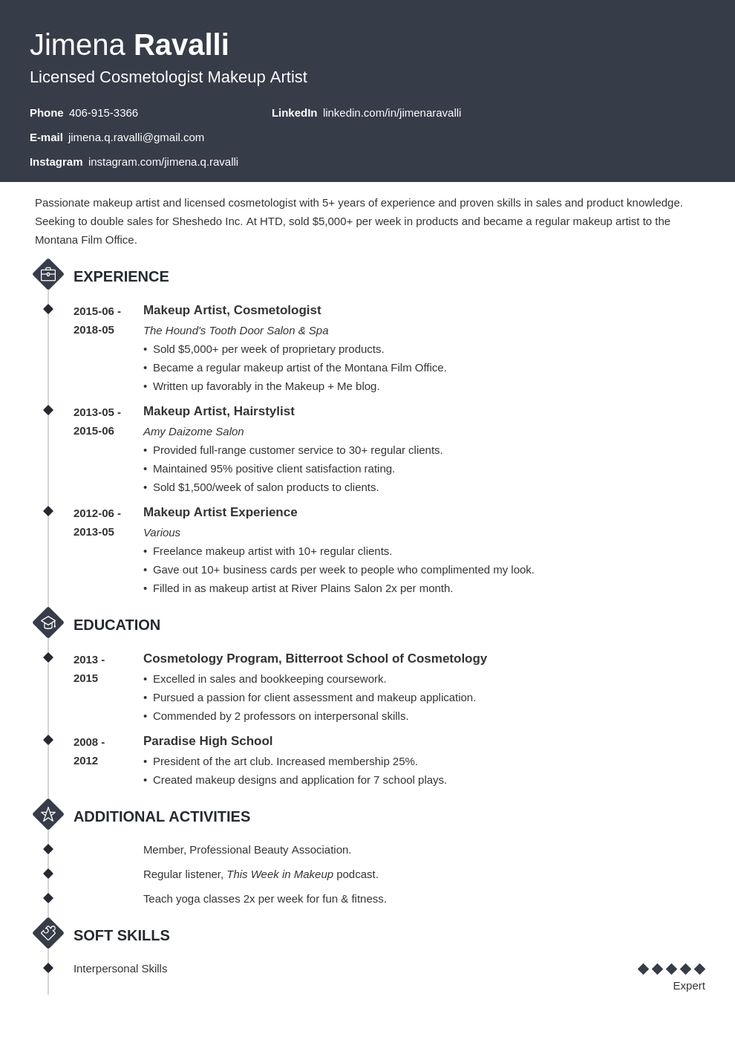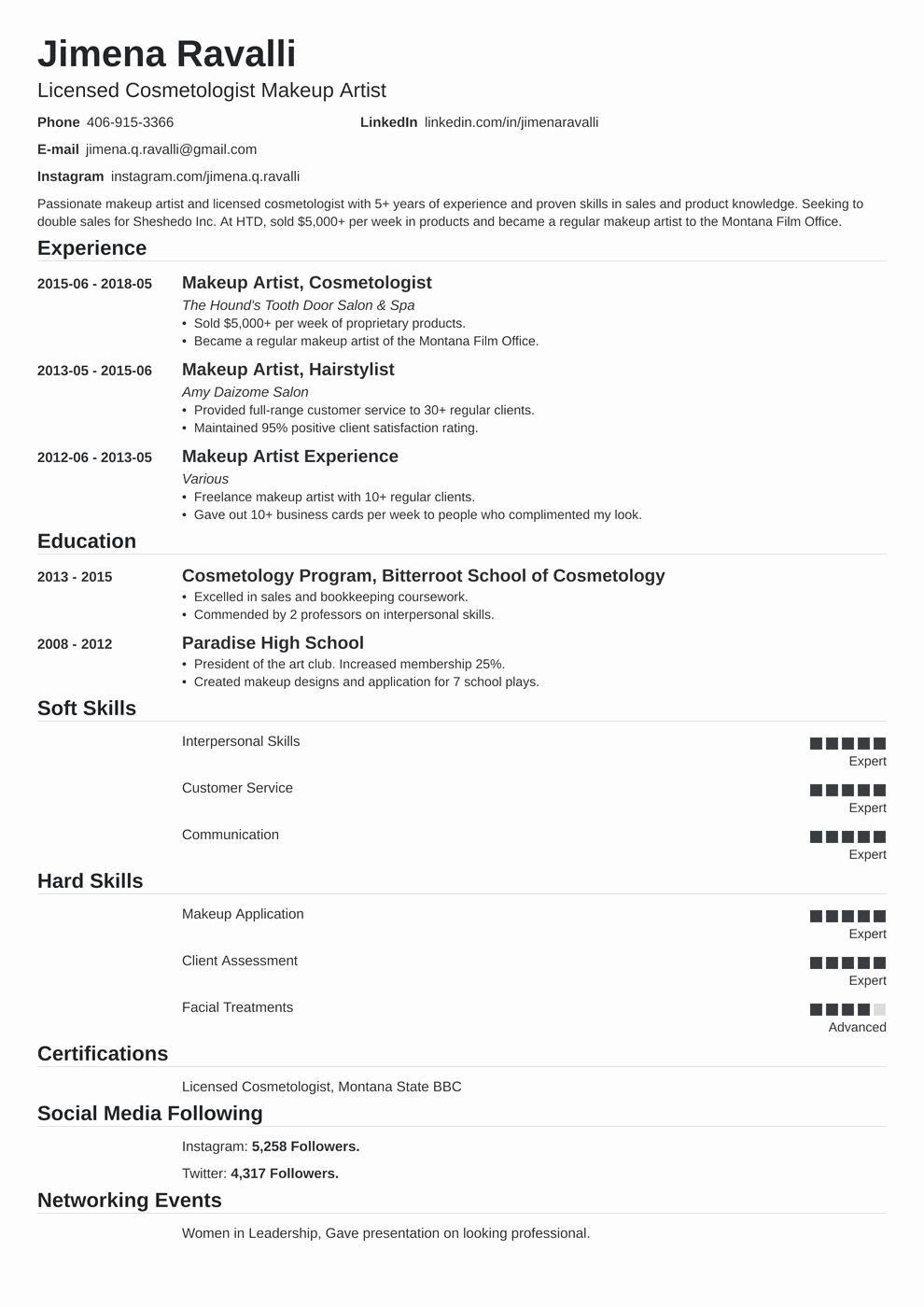Add A Resume Summary Or Objective
After your contact information, you have the option to include either a resume summary or objective statement. An objective statement quickly explains your career goals and is a good choice for those with limited professional experience, such as recent college or high school graduates. A resume summary is a short statement that uses active language to describe your relevant work experience and skills.
How To Write The Position Descriptions On Your Resume
Your position descriptions in your work history are the meat and potatoes of your resume. Your summary will show that you are a fit for an open position at a high level, but the position descriptions are where you prove it. They are where you provide context, detail and impact.
Many resume writers will approach this experience section the same way someone writing a job description would. Document all of the responsibilities, mostly in bullet form. But your resume experience entries aren’t position descriptions at all at least they shouldn’t be. So if you grabbed a dusty job description for your position when you last updated your resume, it’s time for a new approach to writing those position descriptions. Instead of starting the process with your current or past positions and working forward, we are going to start with your desired position and work backward.
What I am about to tell you will, if implemented will:
-
Make your resume more visible in search
-
Make recruiters spend more time reading your resume
-
Increase interest and engagement from recruiters
That sounds good, right?
Your Content Shouldn’t Focus On Responsibilities
“Responsible for” is what many might call “weak sauce.” “Responsible for” just means that someone asked you to do something. Yawn. It doesn’t mean you did it, or did it well. It doesn’t address why you did it or who benefitted. It’s so two dimensional. You want to paint a picture of why the work you did is important and how you excelled at doing it.
Here are the things that I want you to think about including in your position descriptions:
-
The challenge you were solving
-
How that challenge/your work supported the broader strategy of your organization or the company
-
Why the work was important
-
Who else was involved and the nature of the relationship
-
The scale and scope of the work
-
Metrics you used to measure the success of the work
-
The business impact of the work
This might feel like a lot to fit into a bullet point, but you don’t have to! You just want to make sure that you can address what I have listed above in your whole set of bullet points for each position. If you can’t for each position, then focus on incorporating each element across one or more of your roles.
The challenge: Resolve customer issues and requests, and answer questions so that customers have a positive experience, and that negative experiences are managed and prevented in the future.
Broader strategy support: Reduce online chatter, word of mouth and mythology around Uber rides gone wrong.
Some of the info entered above could be bullet points on their own, or some can be combined like this:
Read Also: Do You Put Gpa On Resume
Be Careful With Graphics
Many people choose to include images and graphics to enhance their resumes. However, graphics can sometimes clutter a resume and make it harder for a resume scanner to extract important information from your resume. For this reason, consider focusing on the text of your resume. If you choose to use graphics, try to keep them simple and include them in a way that doesn’t distract from your resume’s text.
Read more:Tips for Creating a Unique Resume
Add In Your Work Experience

This section will most likely be the bulk of your resume. Even if youre changing careers, employers still want to see where youve worked, what youve done, and the impact of that work to get a sense of your background and expertise.
Your Work Experience might be one entire category, or you might choose to break it up into Relevant Experience and Additional Experience to highlight the jobs that are most important for hiring managers to focus on. Either way, youll almost always want to have your most recent experience at the top and your older experience down below.
Within your work experience, youll want to include each official job title, the company , and the years you worked there. Below that, youll add in two to four bullet points explaining what you did in that job, the skills you built and exercised, the tools you used, and the results of what you did. If you accomplished a lot during your time there, focus on the responsibilities that made the most impact or youre the most proud of, as well as the ones that best align you with the job youre applying for . Its key here to list, if relevant, quantitative as well as qualitative accomplishments.
For example, you might write:
Associate Accountant, Finances and Co., Ann Arbor, MI
If you have a ton of experience and this category is starting to run long , consider kicking out your oldest jobs unless theyre super relevant to the job youre applying for, or extra impressive for your field.
You May Like: How To Write Email For Sending Resume
Choose The Best Resume Format
Several basic types of resumes are best for job openings. Depending on your personal and professional circumstances, choose a chronological, functional, combination, or targeted resume. Decide on one that best fits your work experience, educational background, and skill set. Take the time to customize your resume it is well worth the effort as it won’t seem copied.
Whats The Best Resume Format
There is no such thing as the best resume format. The type of resume you choose should be based on your work history, work experience, skills, and qualifications. Here are examples of the formats you can use, and who should use them:
Don’t Miss: How To Insert A Line In Word For Resume
Infographic Video And Website Rsums
As the Internet becomes more driven by multimedia, job-seekers have sought to take advantage of the trend by moving their résumés away from the traditional paper and email media to website résumés or e-résumés.
Video, infographic, and even Vine résumés have gained popularity recently, though mainly in the creative and media industries.
This trend has attracted criticism from human resources management professionals, who warn that this may be a passing fad and point out that multimedia-based résumés may be overlooked by recruiters whose workflow is designed only to accommodate a traditional résumé format.
+ Effective Resume Examples
Knowing how to write a resume is one thing, actually creating a resume that stands out is something else entirely. Without inspiration, even top career experts might stumble on a roadblock or two.
Check out the following effective resume examples to get a better sense of what a good resume looks like…
Want to see more examples? Check out our compilation of 20+ resume examples for different fields.
Also Check: Ged Resume Example
How To Write A Good Resume
Your resume must clearly, concisely and strategically present your qualifications to get a recruiter interested in meeting you. It should convey your skills, work experience and assets. The resume is used to describe what you can accomplish professionally in a manner that also illustrates what you can do for an employer. Job opportunities can arise unexpectedly. An updated modern resume is the key to a successful job search. Here are some do’s and don’ts of how to write a good resume and what to include.
Choose The Perfect Font
Using a unique font can be a simple way to make your resume stand out from a sea of Arial and Times New Roman. There is no right or wrong font when it comes to resumes, but here are a few basic guidelines to keep in mind:
- Make sure any font you use is legible both on a screen and in print. Keep font sizes between 11 and 13 points. Any smaller than that, and even the sleekest font risks becoming illegible.
- Be consistent with how you use different font sizes. For example, all headers should be the same size, as should all body text.
- Sans serif fonts are usually a good option for more creative or digital fields. Serif fonts still have their place in more traditional or old-school industries.
- Avoid using Comic Sans. Not only is it widely despised by people in the design industry, it gives off an childlike vibe. The same can also be said for Papyrus.
Example #1: Sans serif
This resume is using Montserrat, a font found in the Google Fonts database that can be downloaded for free. Notice how the font allows for the entire resume to be read with much more fluidity than a traditional professional resume. The font usage and overall design leads me to believe that this resume would be perfect for someone applying for a more creative or design-oriented job.
Example #2: Sans serif + script
Example #3: Serif + sans serif
Also Check: How To List Cpr Certification On Resume
Choose The Most Suitable Format
Before you start writing anything, the first step is to decide on the right format for your resume. There are three basic resume formats used by job seekers today: reverse-chronological, functional, and combination. Each format has advantages and disadvantages based on how the resume sections are arranged:
Sign Up To A Plan To Download Your Resume

Of course, this step is only necessary for paid resume builders like Zety. There are some free resume builders, such as Resume Genius and NovoResume, that are free to use from start to finish, but they dont give you access to as many templates or helpful tools as the paid options.
In order to download your resume on Zety, youll need to choose from one of three price plans costing $5.99, $17.99, and $34.99 per month.The higher the price plan, the more resumes youll be able to use each month, and the wider range of resume and cover letter features youll have access to.
Top tip:
Recommended Reading: How To Explain Leadership Skills On Resume
Focus On Your Education And Skills
In lieu of a work experience section, it’s best to expand and focus on an education section to highlight the skills you’ve developed on your resume. What can you do well that this job requires? What will be useful to the hiring company? What have you done in school and what have you studied that has prepared you for assuming this job? This is generally a little easier if you’re a college graduate with specialized education, but even a high school graduate can talk about their electives and relevant coursework, why they wanted to take them, and what they learned from the class.
Why Does It Matter If Your Resume Looks Good
It’s important for your resume to look good because your resume is a reflection of your professional qualifications. It can show potential employers that you are a valuable job candidate, which can help you get jobs. Creating a clean, visually appealing resume can help you appear more professional, and it can also make it easier for recruiters to quickly read through your credentials.
Read Also: How To Make An Actors Resume
How To Write A Resume
The Balance
Do you need to write a resume? While it’s only a page or two in length, a resume is one of the most important parts of a job application. Your resume is your most powerful tool to tell the story of your professional work history to potential employers.
A well-written resume that highlights your most relevant qualifications for the job will help you get selected for an interview. Often, interviewers will consult your resume during the interview, too. Above all, your resume needs to be consistent, concise, and easy to read. If it’s not, your resume and cover letter won’t get a second glance from any hiring manager.
In many cases, your resume is the first document a hiring manager will look at when reviewing your application, and therefore is a true first impression. Accordingly, its important to put time and effort into developing and maintaining an updated, accurate resume.
Here is information on how to write a resume that will get noticed and help you get invited for an interview.
Tips For Appealing Language
- Know the jargon. Every occupational field has it’s own set of words, phrases and even verbs to describe what its work. Understanding and using this language shows a familiarity with the field.
- Focus on “hard skills.” Descriptors like “strong communicator” and “team-oriented” are considered “soft skills” by human resources professionals. They are often not included in resume database keyword searches. Focus instead on specific abilities or knowledge.
- Point of View. Resumes generally avoid using the first person “I.” The most traditional way to accomplish this is to start sentences with verbs. Instead of “I managed, organized and planned . . .” use “Managed, organized and planned . . .”
Avoid generalities. Use nouns and verbs that are as specific as possible, cite specifics when listing accomplishments. “Reorganized sales floor resulting in fifty-percent increase in store revenues over two years,” is more effective than, “Reorganized sales floor resulting in increased sales.”
You May Like: How To Do A Resume In Word
Which Resume Type Is Right For You
Which resume type should you use for your job search? That depends on what you’re trying to accomplish. The goal of any resume is to show a hiring manager the applicant’s strengths, skills, and experience in as short a time as possible. According to one study, recruiters spend as little as seven seconds reviewing a resume before moving on to the next, so it’s in your best interests to put your finest qualities and accomplishments in a prominent position on the page.
In addition, functional or combination resumes may also be useful if you’re trying to draw the reader’s attention away from somethingnamely, large gaps in your work history or detours into unrelated fields.
The Last Word On How To Make A Good Resume
Every job, every industry and every candidate will require some adjustments of these resume writing tips. Creative professionals, for example, will want to include links to their portfolios. New college grads wont have much work experience to highlight, but they can still draw from class projects, labs and seminars to talk up their hard and soft skills.
When you consider how to make an amazing resume, the takeaway is this: Employers want to hire people who canmake an impact. Write a tailored resume that shows a distinctive, results-driven professional, and before long you may find yourself preparing for the job interview.
Don’t Miss: List Of Computer Skills To Put On Resume
Make Several Distinct Resumes And Test Which One Gets The Most Responses
Good resumes come in all shapes and sizes, and it can be hard to tell what resume format or design is going to resonate in your industry. Try a couple of different resume designs to see which gets the best response. Once its clear that one resume is bringing in the most leads, stick to using that one. Consider trying out something like Minimal Resume Set in 6 Variations from PremiumCoding, which incorporates several resume designs in one package so you can easily design multiples at once.
Why Is The Design Of My Resume So Important

Employers will usually take, at most, only thirty-five seconds to look at this one-page representation of yourself before deciding whether to keep or discard it. To ensure that you will make it past that initial screening, you should design your résumé in such a way that employers can read the document easily and process information quickly. One way to do this is to conform to the conventional format of a résumé, since employers know how resumes work and where to locate certain information. In addition, you should keep certain design principles in mind that will increase your chances of getting your résumé into the “keep” pile. Designing your résumé can be a challenge and requires you to take a closer look at how readers read. Here are some tips to help you make your résumé a winning experience.
Read Also: How To Include Cpr Certification In Resume
Include An Education Section
An education section will be especially valuable if you have limited work experience or if you are transferring to a new industry. You can include information such as:
- Relevant coursework
- Grade point average
- Participation in clubs or organizations
- Leadership positions held
- Awards, achievements or certifications
When writing your education section, you should include the name of the institution, dates of attendance and your degree or area of study. If you are applying to mid or higher-level positions, you might remove all but the name of your school and dates of attendance to make room for more relevant professional experience on your resume.
If you have certifications or licenses that are relevant to the job description, you can include them in this section as well. To save space, you can leave off any credentials that are not directly related to the requirements of this job.
Related: How to Include Relevant Coursework on a Student Resume